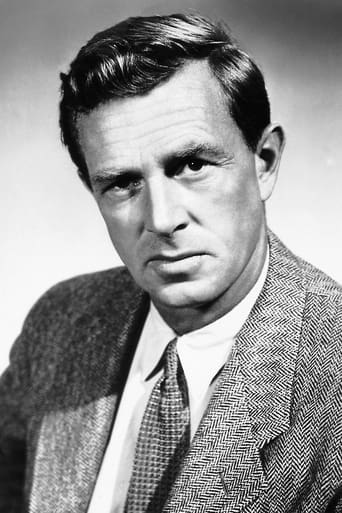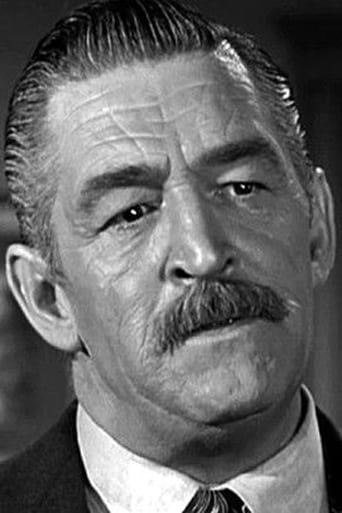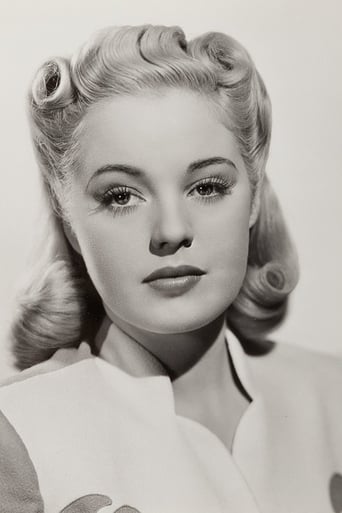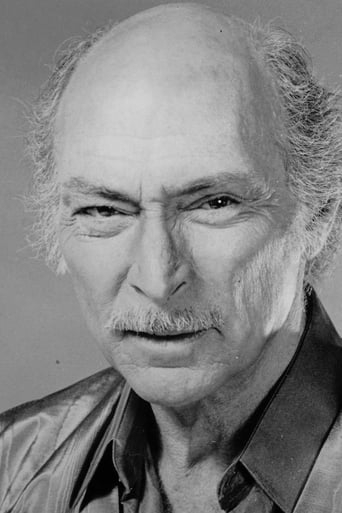Spikeopath
Quite often us Western fans will see the cast list of an old 1950s Western and reasonably expect it to at the very least be a time waster. So instantly we (yes it's the Royal we) notice that Sterling Hayden and Lee Van Cleef star in it, and Ted de Corsia on villain duties as well, and feel quite confident. While when you got a title proudly promising a gun battle it's not outrageous to expect maybe just a little bit of bang bang bangery.That Carl K. Hittlemen's film doesn't deliver any goods is not really his fault, he's a director for hire working with a lazy screenplay and a cast who know it's a lazy screenplay! Cleef escapes criticism, but it's really not a badge of honour to shine in this sea of mediocrity, but he at least makes time spent with the pic tolerable: Just! Come the hopelessly weak finale you are unlikely to care or consider this as being worth another look in some alternate future. Key word is lazy, so this is an appropriately lazy review. 3/10
dougdoepke
Hayden made a number of cheap Westerns at a time (late '50's) when Drive-in's were a booming business and in need of fare. Unfortunately, none are very good, including this one, though a number of talented people were involved in each. As could be expected, most suffered from poor production values and sub-standard scripts, leaving the talent little to work with. That's very much the case here. As others point out, only Van Cleef looks motivated. And too bad that great bad girl Mary Beth Hughes (Cleo) is not given more to work with. No need to repeat negative points made by others, except for two observations. Note that the film has two directors listed. According to IMDb, this was Franklin's only directorial effort, which suggests producer Hittleman didn't like what he saw and so took over the directing himself. Thus the film lacks an experienced director's hand. Also, the ending is indeed startling for a picture of this type. It's so abrupt and unexpected, it's almost like the company suddenly ran out of film and had to wrap up immediately. Certainly, nothing else in the production shows the kind of imagination or nerve that would produce such a startling break with convention. Too bad this remains the only good reason to stick around for this surf-to-turf oater.
Kent Rasmussen
This film has a script so terrible that I reluctantly sat through the entire thing (which is mercifully brief) merely to see how it would play out.SPOILERS ABOUND!The film opens with a shot of a manzanita pine overlooking the ocean that immediately establishes the Monterey, California setting and calls to mind the 1961 Marlon Brando film ONE-EYED JACKS, a film with a very similar storyline that was also set near Monterey. We then see Jay Turner (Sterling Hayden) and Max Reno (Ted de Corsia) riding horses along the surf and learn they are fleeing from a robbery. They go into a cave that Reno calls a perfect hideout. Presumably the entrance to the cave is hidden when the tide is up. However, anyone looking for the men shouldn't have too much trouble finding their horses outside. Morever, Turner builds a fire inside the cave. Don't they worry about the smoke giving them away? (For my part, I'd worry about being drowned inside the cave during high tide.)The men talk and we learn that they've only recently met. They are very different types: Turner is satisfied with the $5,000 he's getting from the heist and wants to give up crime, but Reno wants to continue their partnership and is miffed by Turner's retirement. When Turner goes out to the surf to get a pot of water (What's the water for? Is he intending to use seawater for coffee?) Reno follows him and shoots him in the back. He then takes both horses and flees. This scene stunned me. Why didn't Reno shoot Turner inside the cave, where he could have retrieved the $5,000 and left Turner's body better hidden? Since he seemed not to have retried the money, what was the point of shooting Turner?The next ONE-EYED JACKS element in the film is the appearance of a beautiful young Mexican woman, Maria Salvador (Pamela Duncan), who likes hanging out at the beach alone. Maria drags Turner out of the surf and somehow gets him to her home, where she nurses him back to health. Predictably, Maria and Turner fall in love. Turner is mellowing but is also obsessed with tracking Reno down and returning him to Monterey, where he can be hanged for murder (i.e., murdering Turner). Maria disapproves, but Turner leaves, vowing to return.Meanwhile, Max Reno manages to set himself up nicely, under his own name, in a town called Delrey. It wasn't clear where Delrey is, but it seems to be in or near Texas. A long way from Monterey, California, but it makes some sense, as Reno doesn't appear to be worried about being caught by the law.We first see Reno when he is playing cards in a saloon and winning big. He's obviously cheating, and even the sheriff suggests as much, but he nevertheless wins a huge amount from the saloon's owner. (Would a real saloon owner ever play a complete stranger in a high-stakes poker game?) In a back-room scene, the saloon owner signs over half-interest in his place to Reno, who happens to have a ready-to-sign contract in his jacket pocket. Reno then shoots the man dead and gets away with claiming that the man drew on him. Playing a primitive version of DEADWOOD's Al Swearengen, Reno transforms the formerly tame Delrey saloon into a happening place with fast women, a piano player, and dishonest card dealers.If Delrey really is in Texas, it's a mystery how Turner finds the place, but he does. He makes a dramatic entrance in Reno's saloon and confidently pretends to be "John York" from El Paso when Reno confronts him. It's been a year since Reno has seen Turner, and he never knew Turner well to begin with, so he's not completely sure that York is Turner. He tries a few lame schemes to discover York's true identity. If Reno were Swearengen, he'd simply have York killed to be on the safe side. Eventually, he tries to do just that, but his schemes backfire. Turner ends up as deputy sheriff. Then, as acting sheriff, Turner saves Reno from a lynch mob and takes him back to Monterey. After Turner and Reno leave town, there is a curious sequence in which it becomes unclear what Turner's intentions are. Is he really taking Reno back to Monterey? Does he plan to kill Reno himself? Is he reverting to crime, with Reno as his partner? The answer is (a), and Turner delivers Reno to Monterey sheriff. He then rides back to the beach where he first encountered Maria and finds her pottering around the surf. They fall into each other's arms, but Maria is upset to learn what Turner has done to Reno. Despite the fact that Reno shot Turner in the back and later made several more attempts to have him killed, Maria thinks it wrong to have Reno tried for a murder that didn't take place. Seems like nitpicking, if you ask me. Turner asks Maria if she will love him, no matter what. She says yes, and we next see Turner being put in the same jail cell with Reno.Talk about a movie that doesn't deliver ... there is NO gun battle at Monterey! However, one of the film's few strengths is its ambiguous ending. I expected to see a scene in which Turner is let off the hook for being reformed, but that doesn't happen either. Instead, Reno welcomes Turner into his cell with open arms, forgives him "for everything that you've done to me." The film ends with Turner punching Reno out, as the credits begin to roll. Considering how heavy-handed everything in the script has subtle note. Will Is Turner be prosecuted? Will Reno be hanged? We can only guess. Meanwhile, I wouldn't be surprised if the naive Maria goes back to the beach to pick up more men.
Robert J. Maxwell
Don't watch this. Honest, you'll be bored.I saw it because the description of the plot on my guide grabbed me by the lapels and shook me awake. Something like, "A thief is shot by his partner who runs off with the loot. Saved by a Mexican girl, he sets out for revenge." "Gun Battle in Monterey"? It sounded like "One-Eyed Jacks." But it's not. "One-Eyed Jacks" may have had its longeurs but they were nothing compared to this one, a standard-typical Western into which no one involved seems to have put the least effort.Yes, Sterling Hayden is betrayed and left for dead by his cowardly partner, Ted DeCorsia, and plots revenge but is saved by the moralistic preaching of his Mexican girlfriend. That's about where the similarity ends.Hayden must have done this for the money. He was an actor of limited range but no one ever asked him to deliver very much except Stanley Kubrick. Hayden brought a touch of real pathos to the role of the delusional General Jack D. Ripper in "Doctor Strangelove." Here he doesn't give an inch. He was a much better writer and sailor than a Western hero. Ted DeCorsia is simply Ted DeCorsia, more of a coward than a sadist. The women are perfunctory. Possibly the best performance is given by Lee Van Cleef, a really shifty looking heavy with a strong baritone. The script also gives him one or two lines suggesting he's human a little as well as feral a lot.The supporting players, aside from Byron Fulger who should know better, are sadly unendowed with talent. Not a believable line from any of them. And the director adds absolutely nothing to the Grade-B shenanigans we see on the screen.This could have been a John Wayne western from Poverty Row in 1935. One of those masterpieces where Wayne rides full tilt after the stagecoach along a dusty road lined with telephone poles, past parked trucks. The budget for this movie must have been nearly non-existent and the shooting schedule, I would guess, ran somewhere around 2 hours and 13 minutes.Pathetic.




